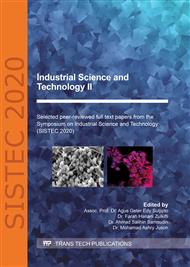p.77
p.82
p.91
p.97
p.104
p.110
p.116
p.122
p.128
Azolla Biomass as Liquid Biofertilizer to Improve Yield and Productivity of Paddy Plant Using Efficient Monitoring System
Abstract:
Azolla Filliculoides has been utilized as biofertilizer to increase productivity and yield of paddy. Azolla was used as a good source of nutrient to the paddy plant. In this study, we investigated the growth and productivity of paddy plant supplemented with liquid Azolla biofertilizer. The preparation of Azolla was monitored under several parameters such as pH, dissolved oxygen, temperature, and salinity in an aquaponics system. Water quality analysis of the aquaponic system was monitored by using the Arduino system which the customized design that consists of a microcontroller to record the parameters directly to the computing device in a single optimum and efficient system. The nutrient composition of liquid Azolla biofertilizer was analyzed by using Inductively Coupled Plasma Mass Spectrometry (ICP/MS) and CHNS elemental analysers. hows that liquid Azolla contents 0.958% nitrogen, 15.5 ppm phosphorus and 159.8 ppm potassium. After four months, the yield of paddy on Azolla was 149.12 kg/he with the productivity of 63.157 kg/he/year. This application helped to an efficient monitoring system for measure high yield and productivity of biofertilizer by Arduino software monitoring. This study can act as an initial step for the web-based automated control and monitoring of the food production system.
Info:
Periodical:
Pages:
104-109
Citation:
Online since:
March 2021
Keywords:
Price:
Сopyright:
© 2021 Trans Tech Publications Ltd. All Rights Reserved
Share:
Citation:


